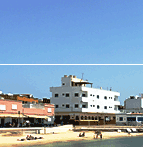Lobos Island 2025: Complete Guide to Fuerteventura's Pristine Paradise
Discover the breathtaking beauty of Lobos Island, a UNESCO Biosphere Reserve just 15 minutes from Corralejo! This pristine volcanic island paradise offers an extraordinary day trip experience from the world's best beach destination. With crystal-clear lagoons, dramatic volcanic landscapes, unique hiking trails, and some of the best snorkeling in the Canary Islands, Lobos Island provides an unforgettable escape into one of the Atlantic's last untouched natural environments. Following Corralejo's National Geographic recognition, visitor interest in nearby Lobos Island has surged, making advance planning essential for this bucket-list destination.
🏝️ About Lobos Island: UNESCO Biosphere Reserve
Lobos Island (Isla de Lobos) represents one of the Canary Islands' most pristine and protected natural environments. This small volcanic island spans just 4.6 square kilometers but contains an extraordinary diversity of ecosystems, rare endemic species, and geological formations that have earned it UNESCO Biosphere Reserve status. The island's name derives from the monk seals (lobos marinos) that once inhabited its shores, though these magnificent creatures are now extinct from the area.
The island's unique position between Fuerteventura and Lanzarote creates exceptional biodiversity and pristine marine environments. Protected status since 1982 has preserved the island's natural beauty, allowing visitors to experience one of the last truly wild places in the Canary Islands. The island remains uninhabited except for a small restaurant and visitor facilities, ensuring that natural ecosystems remain undisturbed while providing carefully managed access for nature enthusiasts.
Geological wonders include ancient volcanic formations, natural arches, hidden coves, and unique salt lagoons that create diverse habitats for rare plant species and migrating birds. The island's volcanic origin is evident throughout, with black lava rock formations contrasting beautifully with turquoise waters and pristine white sand beaches that rival any tropical paradise.
🚢 Ferry Service & Transportation 2025
Ferry Schedule & Frequency
Regular ferry service operates 14 trips daily during peak season, providing flexible scheduling for day trips. The ferry journey takes approximately 15-20 minutes each way, departing from Corralejo harbor's dedicated Lobos Island terminal. During peak tourist seasons (December-March, June-September), service frequency increases to accommodate higher demand, while winter months maintain reduced but consistent scheduling.
Typical Daily Schedule (Subject to Seasonal Variation): Departures from Corralejo begin at 9:00am and continue throughout the day until 5:00pm, with return trips from Lobos Island operating until 6:30pm. Ferry companies recommend arriving at the terminal 30 minutes before departure to complete check-in procedures and permit verification.
Ferry Operators & Booking
Naviera Nortour and other licensed operators provide safe, reliable transportation with modern vessels. Boats feature comfortable seating, safety equipment, and often include brief commentary about the island's history and ecology during the crossing. Advanced booking is strongly recommended, especially during peak seasons when ferries frequently reach capacity.
Water taxi services offer more flexible scheduling and smaller group experiences for visitors seeking personalized transportation. These services typically accommodate 6-12 passengers and can arrange custom departure times, though they operate at higher cost than regular ferry services.
Ferry Terminal & Departure Information
The Lobos Island ferry terminal is located in Corralejo's main harbor area, easily accessible from all hotels and accommodation. The terminal features waiting areas, restroom facilities, and information services to assist visitors with trip planning. Clear signage in multiple languages guides visitors through check-in processes and permit requirements.
Parking is available near the terminal, though spaces fill quickly during peak hours. Many visitors choose to walk to the terminal from Corralejo's town center or use local transportation services. Hotel shuttle services to the ferry terminal are offered by some accommodations during busy periods.
📋 Permits & Regulations 2025
Required Permits & Advance Booking
All visitors must obtain advance permits through the official Cabildos de Fuerteventura website or authorized booking agents. The permit system limits daily visitor numbers to protect the island's fragile ecosystems while ensuring quality experiences for all guests. Permits specify exact visit dates and ferry departure times, requiring strict adherence to scheduled itineraries.
Permit booking should be completed 1-7 days in advance, with earlier booking recommended during peak seasons. The free permit system requires basic information including visitor names, passport numbers, and preferred visit dates. Permits are linked to specific ferry departures and cannot be transferred between different travel dates or times.
Visitor Regulations & Restrictions
Strict environmental protection regulations govern all island activities to preserve the UNESCO Biosphere Reserve status. Visitors must remain on designated trails, avoid disturbing wildlife, and carry out all waste to maintain the island's pristine condition. Swimming and snorkeling are permitted in designated areas, while camping, fires, and overnight stays are strictly prohibited.
Group size limitations and guided tour requirements apply to certain sensitive areas of the island. Professional guides provide ecological education and ensure compliance with conservation regulations while enhancing visitor understanding of the island's unique ecosystems and geological features.
🥾 Hiking Trails & Exploration
Main Hiking Circuit
The primary hiking trail forms a circular route covering approximately 3.5 kilometers of varied terrain and spectacular scenery. This well-marked trail takes 2-3 hours to complete at a leisurely pace, including stops for photography and wildlife observation. The route encompasses diverse landscapes from coastal areas to volcanic interior regions, providing comprehensive exposure to the island's natural beauty.
Trail highlights include panoramic viewpoints offering 360-degree views of Fuerteventura, Lanzarote, and the surrounding Atlantic Ocean. Strategic rest areas with shaded seating allow visitors to appreciate the expansive vistas while observing seabirds and marine life in their natural habitats. Clear trail markers and distance indicators help visitors plan their exploration and ensure they remain on designated paths.
Punta Martiño Lighthouse Trail
The historic lighthouse trail leads to Lobos Island's most iconic landmark and highest viewpoint. This moderately challenging hike rewards visitors with breathtaking panoramic views encompassing both neighboring islands and vast ocean horizons. The lighthouse, built in 1865, represents important maritime heritage and provides excellent opportunities for photography and scenic appreciation.
The trail to Punta Martiño covers diverse volcanic landscapes including ancient lava flows, crater formations, and unique geological features. Interpretive signage along the route explains volcanic processes, local ecology, and the island's formation history, enhancing educational value for visitors interested in geology and natural sciences.
Coastal Exploration Routes
Several shorter trails provide access to secluded beaches, natural swimming pools, and dramatic coastal formations. These routes offer more relaxed hiking options suitable for families and visitors seeking less strenuous exploration. Coastal trails showcase the island's pristine beaches, hidden coves, and crystal-clear lagoons perfect for swimming and snorkeling.
Tide pool exploration areas along the coast reveal fascinating marine life including colorful fish, sea urchins, and unique Atlantic species. These natural aquariums provide educational opportunities for children and adults interested in marine biology, while the shallow, protected waters offer safe swimming and snorkeling experiences.
🏊♂️ Swimming & Snorkeling
Best Swimming Areas
La Concha lagoon offers the most popular and accessible swimming area with calm, shallow waters perfect for all ages. This natural lagoon features crystal-clear turquoise water, soft white sand, and protection from ocean currents, creating ideal conditions for relaxation and safe swimming. The lagoon's unique beauty makes it one of the most photographed locations in the Canary Islands.
Additional swimming areas include several smaller coves and beaches accessible via hiking trails. These more secluded locations offer privacy and pristine conditions for visitors seeking quieter beach experiences away from the main visitor areas. Each swimming location features different characteristics, from calm lagoons to more dynamic ocean access points.
Snorkeling Opportunities
Lobos Island's protected marine environment provides exceptional snorkeling with remarkable underwater visibility and diverse marine life. The island's UNESCO Biosphere Reserve status extends to surrounding waters, ensuring pristine underwater ecosystems with healthy coral formations, diverse fish species, and excellent water quality.
Popular snorkeling spots include rocky areas near Punta Martiño and the eastern coastline where volcanic formations create diverse underwater landscapes. Snorkelers commonly encounter parrotfish, angelfish, damselfish, octopus, and various ray species in their natural habitats. Underwater photography opportunities abound with excellent visibility typically exceeding 20 meters.
Water Safety & Conditions
Swimming and snorkeling conditions remain excellent throughout the year due to the island's protected location and calm surrounding waters. Water temperatures range from 18°C (64°F) in winter to 24°C (75°F) in summer, making water activities comfortable year-round. The absence of dangerous marine life and strong currents creates safe conditions for swimmers of all abilities.
Visitors should bring their own snorkeling equipment as rental options are limited on the island. Sun protection is essential due to intense solar exposure and reflection from white sand and clear water. Fresh water for rinsing is available at the main visitor facilities near the ferry landing area.
🍽️ Dining & Facilities
Puertito Restaurant
The island's only restaurant, Puertito, provides authentic Canarian cuisine in a spectacular oceanfront setting. This family-run establishment specializes in fresh seafood, traditional island dishes, and simple grilled preparations that highlight local ingredients and traditional cooking methods. The restaurant's terrace offers panoramic ocean views and represents one of the most unique dining experiences in the Canary Islands.
Menu highlights include fresh fish caught in surrounding waters, traditional Canarian potatoes with mojo sauce, local goat cheese, and seasonal specialties that reflect the island's culinary heritage. The restaurant operates only during daylight hours and closes before the last ferry departure, requiring visitors to plan their dining timing accordingly.
Visitor Facilities & Services
Basic visitor facilities near the ferry landing include restroom facilities, fresh water access, and information services. These facilities are maintained to support day visitors while minimizing environmental impact on the protected island ecosystem. Waste disposal facilities encourage visitors to maintain the island's pristine condition.
No overnight accommodation, shops, or extensive commercial facilities exist on the island, preserving its natural character and protecting sensitive ecosystems. Visitors must bring all necessary supplies including water, sun protection, snorkeling equipment, and food if not dining at the restaurant. This limitation ensures authentic wilderness experiences while supporting conservation goals.
🌿 Wildlife & Nature
Endemic Plant Species
Lobos Island hosts several rare and endemic plant species adapted to the harsh volcanic environment and salt spray conditions. The island's flora includes unique succulents, salt-resistant shrubs, and rare coastal plants that have evolved specifically for these challenging conditions. Botanical enthusiasts can observe adaptation strategies including water storage systems, salt filtering mechanisms, and wind resistance features.
Protected plant communities include rare sea lavender, endemic spurge species, and salt marsh vegetation that provide critical habitat for wildlife while preventing soil erosion. Visitor education programs highlight the importance of staying on designated trails to protect these fragile plant communities from trampling and disturbance.
Bird Watching Opportunities
The island serves as an important stopover point for migratory birds and breeding ground for several seabird species. Ornithologists and bird watching enthusiasts can observe shearwaters, petrels, terns, and various gull species that nest on the island's cliffs and remote areas. The protected status ensures minimal disturbance to nesting sites while providing excellent observation opportunities.
Seasonal migration periods offer particularly exciting bird watching with species from Europe and Africa using the island as a rest stop. Spring and fall migrations bring the greatest diversity, while year-round residents include several endemic subspecies adapted to island conditions. Binoculars are recommended for optimal bird watching experiences.
Marine Life
Surrounding waters support diverse marine ecosystems including important fish nursery areas and coral communities. The protected marine environment allows fish populations to thrive, creating excellent opportunities for underwater observation and photography. Marine mammals including dolphins and pilot whales occasionally visit the waters around Lobos Island.
Rocky shoreline areas reveal fascinating tide pool ecosystems with colorful sea anemones, crabs, and small fish that adapt to changing tidal conditions. These natural aquariums provide educational opportunities and safe marine life observation for visitors of all ages.
📅 Best Times to Visit
Seasonal Considerations
Lobos Island offers excellent visiting conditions throughout the year, with each season providing unique advantages for different activities. Spring (March-May) and fall (September-November) offer ideal hiking conditions with moderate temperatures and fewer crowds, while summer provides optimal swimming and snorkeling conditions with warmest water temperatures.
Winter months (December-February) feature cooler temperatures perfect for hiking and wildlife observation, with increased bird activity during migration periods. Weather remains generally pleasant year-round, though winter months may experience occasional rain showers and stronger winds that can affect ferry operations.
Daily Timing Recommendations
Early morning ferries provide optimal island experiences with cooler temperatures for hiking and better wildlife observation opportunities. Morning visits allow complete circuit hiking before afternoon heat becomes intense, while evening light provides excellent photography conditions. Most visitors prefer spending 4-6 hours on the island to fully explore hiking trails and enjoy swimming or snorkeling.
Sunset viewing from Punta Martiño lighthouse offers spectacular photography opportunities, though visitors must ensure return ferry scheduling accommodates evening activities. The island's western orientation provides excellent sunset viewing, while early morning visits offer sunrise photography from eastern viewpoints.
🎒 What to Bring & Preparation
Essential Items
Comprehensive preparation ensures safe and enjoyable island exploration in this remote natural environment. Essential items include sufficient water (minimum 2 liters per person), sun protection (hat, sunscreen SPF 50+, sunglasses), comfortable hiking shoes with good grip, and layers for temperature variations. No shops exist on the island, making thorough preparation crucial.
Additional recommended items include snorkeling equipment, waterproof bag for electronics, first aid supplies, insect repellent, and high-energy snacks. Camera equipment should include extra batteries and memory cards, while reef-safe sunscreen protects both visitors and marine ecosystems.
Physical Preparation
Moderate physical fitness enables full enjoyment of hiking trails and island exploration. While trails are well-maintained, volcanic terrain can be challenging with uneven surfaces, loose rocks, and elevation changes. Visitors should assess their hiking abilities and choose appropriate routes based on fitness levels and available time.
Heat awareness and hydration planning are crucial for safe island exploration, especially during summer months. The island offers limited shade, making sun protection and regular water intake essential for preventing heat-related illness. Early morning starts help avoid peak heat periods while maximizing exploration time.
💡 Insider Tips & Local Knowledge
Photography Opportunities
Lobos Island provides some of the most spectacular photography opportunities in the Canary Islands with diverse landscapes and pristine natural beauty. The lighthouse viewpoint offers panoramic shots encompassing both neighboring islands, while La Concha lagoon provides iconic tropical paradise imagery. Golden hour lighting creates magical conditions for landscape photography.
Underwater photography opportunities abound with excellent visibility and diverse marine life in crystal-clear waters. Waterproof camera equipment captures colorful fish species, coral formations, and unique underwater volcanic landscapes. Drone photography may be restricted in certain areas due to wildlife protection regulations.
Avoiding Crowds
Strategic timing and route planning help visitors avoid peak crowds while maximizing island exploration opportunities. Early morning ferries and weekday visits typically provide quieter experiences with better wildlife observation opportunities. Hiking trails offer more solitude away from the main beach areas where most visitors concentrate.
Off-season visits (October-May) provide the most authentic wilderness experiences with fewer visitors and increased wildlife activity. Local weather patterns and ferry schedules may vary seasonally, requiring flexible planning and advance confirmation of transportation availability.
Environmental Responsibility
Visitors play crucial roles in preserving Lobos Island's pristine condition for future generations through responsible tourism practices. Following Leave No Trace principles, staying on designated trails, and respecting wildlife habitats ensure the island maintains its UNESCO Biosphere Reserve status and natural beauty.
Supporting conservation efforts through educational awareness and responsible visiting practices helps protect this unique ecosystem. Visitors should report any environmental concerns to ferry operators or island authorities while sharing conservation messages with other travelers to promote sustainable tourism.
Ready to explore Lobos Island paradise? This extraordinary UNESCO Biosphere Reserve offers one of the most pristine and accessible natural experiences in the Atlantic Ocean. Just 15 minutes from Corralejo's world-famous beaches, Lobos Island provides unforgettable hiking, snorkeling, and wildlife observation opportunities in one of the Canary Islands' last untouched wilderness areas. Plan your advance permits, pack your adventure gear, and prepare for an extraordinary day trip to this volcanic island paradise!









